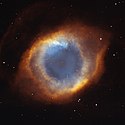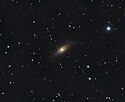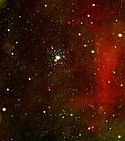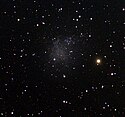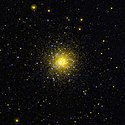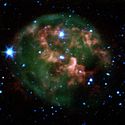Caldwellkatalogen

Caldwellkatalogen är en astronomisk katalog på 109 stjärnhopar, nebulosor och galaxer för amatörastronomer. Listan skapades av Patrick Moore som ett komplement till Messiers katalog.[1]
Moore märkte att Messiers katalog, som används av många amatörastronomer till som en lista på deep-sky-objekt att observera saknar flera av himlens ljusaste objekt,[1] såsom Hyaderna, Dubbelhopen (NGC 869 och NGC 884) och Bildhuggargalaxen (NGC 253). Moore märkte också att eftersom Messier gjorde sin lista utgående från observationer gjorda i Paris, innehöll listan inte flera ljusa objekt längre söderut, som Omega Centauri, Centaurus A, the NGC 4755 och 47 Tucanae.[1][2] Moore skapade en lista på 109 objekt – för att ha samma antal objekt som Messiers katalog (110 minus Messier 102 som i verklighet är samma objekt som Messier 101.)[1] Listan publicerades i Sky & Telescope i december 1995.[3] Moore använde sitt andra efternamn (Caldwell) som listans namn, eftersom den första bokstaven av "Moore" redan används för Messiers katalog.[4][1] Objekt i katalogen är listade med ett "C" och numret av objektet (1 till 109).
Tvärtemot objekten i Messiers katalog, som är listade ungefär i upptäcktsordningen,[5] är Caldwellobjekten listade enligt deklination, C1 längst norrut och C109 längst söderut.[1] Vissa fel har förekommit i listan, exempelvis identifierade den S Norma-hopen (NGC 6087) som NGC 6067 och kallade Lambda Centauri-hopen (IC 2944) för Gamma Centauri-hopen.[1]
Karta över Caldwellobjekten
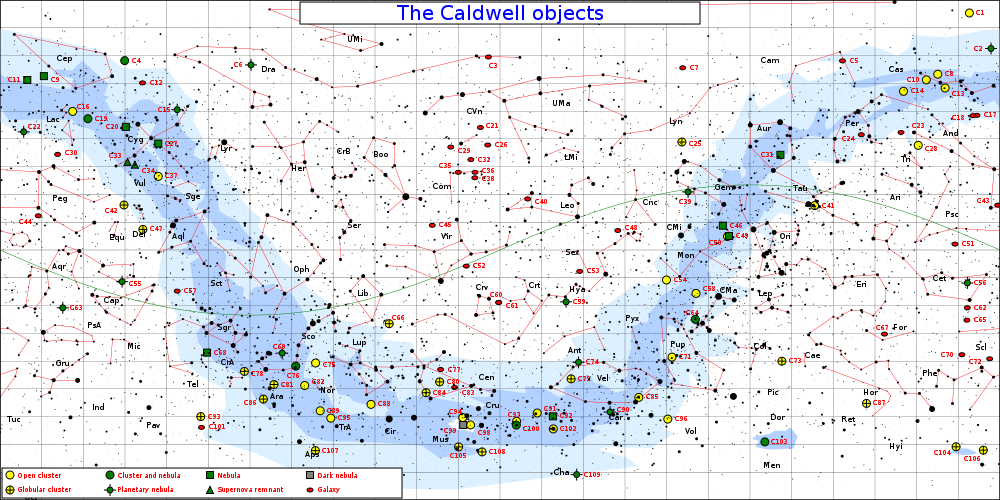
Antalet objekt per typ i Caldwellkatalogen.
| Mörka nebulosor | 1 |
| Galaxer | 35 |
| Klotformiga stjärnhopar | 18 |
| Nebulosor | 9 |
| Stjärnhopar | 25 |
| Stjärnhopar och nebulosor | 6 |
| Planetariska nebulosor | 13 |
| Supernovarester | 2 |
| Totalt | 109 |
Caldwellobjekten
Nyckel
| Stjärnhop |
| Nebulosa |
| Galax |
1–10
| Nr. | NGC-beteckning | Namn | Bild | Typ | Avstånd till objektet i tusen ljusår | Stjärnbild | Skenbar magnitud |
|---|---|---|---|---|---|---|---|
| C1 | NGC 188 | Öppen stjärnhop | 4.8 | Cepheus | 8.1 | ||
| C2 | NGC 40 | Planetarisk nebulosa | 3.5 | Cepheus | 11 | ||
| C3 | NGC 4236 |  | Galax | 7,000 | Draken | 9.7 | |
| C4 | NGC 7023 | Irisnebulosan | Öppen stjärnhop och nebulosa | 1.4 | Cepheus | 7 | |
| C5 | IC 342 |  | Galax | 10,000 | Giraffen | 9 | |
| C6 | NGC 6543 | Kattögenebulosan |  | Planetarisk nebulosa | 3 | Draken | 9 |
| C7 | NGC 2403 | Galax | 14,000 | Giraffen | 8.4 | ||
| C8 | NGC 559 |  | Öppen stjärnhop | 3.7 | Cassiopeja | 9.5 | |
| C9 | Sh2-155 | Nebulosa | 2.8 | Cepheus | 7.7 | ||
| C10 | NGC 663 | Öppen stjärnhop | 7.2 | Cassiopeja | 7.1 |
11–20
| Nr. | NGC-beteckning | Namn | Bild | Typ | Avstånd till objektet i tusen ljusår | Stjärnbild | Skenbar magnitud |
|---|---|---|---|---|---|---|---|
| C11 | NGC 7635 |  | Nebulosa | 7.1 | Cassiopeja | - | |
| C12 | NGC 6946 |  | Galax | 18,000 | Cepheus | 8.9 | |
| C13 | NGC 457 | Ugglehopen | Öppen stjärnhop | - | Cassiopeja | 6.4 | |
| C14 | NGC 869 & NGC 884 | H & χ Persei | Öppen stjärnhop | 7.3 | Perseus | 4 | |
| C15 | NGC 6826 |  | Planetarisk nebulosa | 2.2 | Svanen | 10 | |
| C16 | NGC 7243 | Öppen stjärnhop | 2.5 | Ödlan | 6.4 | ||
| C17 | NGC 147 |  | Galax | 2,300 | Cassiopeja | 9.3 | |
| C18 | NGC 185 | Galax | 2,300 | Cassiopeja | 9.2 | ||
| C19 | IC 5146 | Öppen stjärnhop och nebulosa | 3.3 | Svanen | 7.2 | ||
| C20 | NGC 7000 | Nordamerikanebulosan |  | Nebulosa | 1.8 | Svanen | 4 |
21–30
| Nr. | NGC-beteckning | Namn | Bild | Typ | Avstånd till objektet i tusen ljusår | Stjärnbild | Skenbar magnitud |
|---|---|---|---|---|---|---|---|
| C21 | NGC 4449 | Galax | 10,000 | Jakthundarna | 9.4 | ||
| C22 | NGC 7662 |  | Planetarisk nebulosa | 3.2 | Andromeda | 9 | |
| C23 | NGC 891 | Galax | 31,000 | Andromeda | 10 | ||
| C24 | NGC 1275 | Perseus A |  | Galax | 230,000 | Perseus | 11.6 |
| C25 | NGC 2419 |  | Klotformig stjärnhop | 275 | Lodjuret | 10.4 | |
| C26 | NGC 4244 | Galax | 10,000 | Jakthundarna | 10.2 | ||
| C27 | NGC 6888 |  | Nebulosa | 4.7 | Svanen | 7.4 | |
| C28 | NGC 752 | Öppen stjärnhop | 1.2 | Andromeda | 5.7 | ||
| C29 | NGC 5005 | Galax | 69,000 | Jakthundarna | 9.8 | ||
| C30 | NGC 7331 | Galax | 47,000 | Pegasus | 9.5 |
31–40
| Nr. | NGC-beteckning | Namn | Bild | Typ | Avstånd till objektet i tusen ljusår | Stjärnbild | Skenbar magnitud |
|---|---|---|---|---|---|---|---|
| C31 | IC 405 |  | Nebulosa | 1.6 | Kusken | - | |
| C32 | NGC 4631 | Galax | 22,000 | Jakthundarna | 9.3 | ||
| C33 | NGC 6992 | Supernovarest | 2.5 | Svanen | - | ||
| C34 | NGC 6960 | Supernovarest | 2.5 | Svanen | - | ||
| C35 | NGC 4889 |  | Galax | 300,000 | Berenikes hår | 11.4 | |
| C36 | NGC 4559 |  | Galax | 32,000 | Berenikes hår | 9.9 | |
| C37 | NGC 6885 | Öppen stjärnhop | 1.95 | Räven | 6 | ||
| C38 | NGC 4565 |  | Galax | 32,000 | Berenikes hår | 9.6 | |
| C39 | NGC 2392 | Eskimonebulosan |  | Planetarisk nebulosa | 4 | Tvillingarna | 10 |
| C40 | NGC 3626 | Galax | 86,000 | Lejonet | 10.9 |
41–50
| Nr. | NGC-beteckning | Namn | Bild | Typ | Avstånd till objektet i tusen ljusår | Stjärnbild | Skenbar magnitud |
|---|---|---|---|---|---|---|---|
| C41 | Mel 25 | Hyaderna |  | Öppen stjärnhop | 0.151 | Oxen | 0.5 |
| C42 | NGC 7006 | Klotformig stjärnhop | 135 | Delfinen | 10.6 | ||
| C43 | NGC 7814 | Galax | 49,000 | Pegasus | 10.5 | ||
| C44 | NGC 7479 | Galax | 106,000 | Pegasus | 11 | ||
| C45 | NGC 5248 |  | Galax | 74,000 | Björnvaktaren | 10.2 | |
| C46 | NGC 2261 | Hubbles variabelnebulosa |  | Nebulosa | 2.5 | Enhörningen | - |
| C47 | NGC 6934 |  | Klotformig stjärnhop | 57 | Delfinen | 8.9 | |
| C48 | NGC 2775 |  | Galax | 55,000 | Kräftan | 10.3 | |
| C49 | NGC 2237 | Rosettenebulosan |  | Nebulosa | 4.9 | Enhörningen | 9.0 |
| C50 | NGC 2244 |  | Öppen stjärnhop | 4.9 | Enhörningen | 4.8 |
51–60
| Nr. | NGC-beteckning | Namn | Bild | Typ | Avstånd till objektet i tusen ljusår | Stjärnbild | Skenbar magnitud |
|---|---|---|---|---|---|---|---|
| C51 | IC 1613 |  | Galax | 2,300 | Valfisken | 9.3 | |
| C52 | NGC 4697 | Galax | 76,000 | Jungfrun | 9.3 | ||
| C53 | NGC 3115 | Spindelgalaxen |  | Galax | 22,000 | Sextanten | 9.2 |
| C54 | NGC 2506 | Öppen stjärnhop | 10 | Enhörningen | 7.6 | ||
| C55 | NGC 7009 | Saturnusnebulosan |  | Planetarisk nebulosa | 1.4 | Vattumannen | 8 |
| C56 | NGC 246 |  | Planetarisk nebulosa | 1.6 | Valfisken | 8 | |
| C57 | NGC 6822 | Barnards galax |  | Galax | 2,300 | Skytten | 9 |
| C58 | NGC 2360 | Öppen stjärnhop | 3.7 | Stora Hunden | 7.2 | ||
| C59 | NGC 3242 |  | Planetarisk nebulosa | 1.4 | Vattenormen | 9 | |
| C60 | NGC 4038 | Antenngalaxerna |  | Galax | 83,000 | Korpen | 10.7 |
61–70
| Nr. | NGC-beteckning | Namn | Bild | Typ | Avstånd till objektet i tusen ljusår | Stjärnbild | Skenbar magnitud |
|---|---|---|---|---|---|---|---|
| C61 | NGC 4039 | Antenngalaxerna |  | Galax | 83,000 | Korpen | 13 |
| C62 | NGC 247 | Galax | 6,800 | Valfisken | 8.9 | ||
| C63 | NGC 7293 | Helixnebulosan |  | Planetarisk nebulosa | 0.522 | Vattumannen | 7.3 |
| C64 | NGC 2362 |  | Öppen stjärnhop och nebulosa | 5.1 | Stora Hunden | 4.1 | |
| C65 | NGC 253 | Bildhuggargalaxen |  | Galax | 9,800 | Bildhuggaren | 7.1 |
| C66 | NGC 5694 | Klotformig stjärnhop | 113 | Vattenormen | 10.2 | ||
| C67 | NGC 1097 |  | Galax | 47,000 | Ugnen | 9.3 | |
| C68 | NGC 6729 | R CrA-nebulosan |  | Nebulosa | 0.424 | Södra kronan | - |
| C69 | NGC 6302 | Fjärilsnebulosan |  | Planetarisk nebulosa | 5.2 | Skorpionen | 13 |
| C70 | NGC 300 | Galax | 3,900 | Bildhuggaren | 9 |
71–80
| Nr. | NGC-beteckning | Namn | Bild | Typ | Avstånd till objektet i tusen ljusår | Stjärnbild | Skenbar magnitud |
|---|---|---|---|---|---|---|---|
| C71 | NGC 2477 | Öppen stjärnhop | 3.7 | Akterskeppet | 5.8 | ||
| C72 | NGC 55 | Galax | 4,200 | Bildhuggaren | 8 | ||
| C73 | NGC 1851 |  | Klotformig stjärnhop | 39.4 | Duvan | 7.3 | |
| C74 | NGC 3132 | Planetarisk nebulosa | 2 | Seglet | 8 | ||
| C75 | NGC 6124 | Öppen stjärnhop | 1.5 | Skorpionen | 5.8 | ||
| C76 | NGC 6231 | Öppen stjärnhop och nebulosa | 6 | Skorpionen | 2.6 | ||
| C77 | NGC 5128 | Centaurus A |  | Galax | 16,000 | Kentauren | 7 |
| C78 | NGC 6541 | Klotformig stjärnhop | 22.3 | Södra kronan | 6.6 | ||
| C79 | NGC 3201 |  | Klotformig stjärnhop | 17 | Seglet | 6.8 | |
| C80 | NGC 5139 | Omega Centauri |  | Klotformig stjärnhop | 17.3 | Kentauren | 3.7 |
81–90
| Nr. | NGC-beteckning | Namn | Bild | Typ | Avstånd till objektet i tusen ljusår | Stjärnbild | Skenbar magnitud |
|---|---|---|---|---|---|---|---|
| C81 | NGC 6352 |  | Klotformig stjärnhop | 18.6 | Altaret | 8.2 | |
| C82 | NGC 6193 |  | Öppen stjärnhop | 4.3 | Altaret | 5.2 | |
| C83 | NGC 4945 | Galax | 17,000 | Kentauren | 9 | ||
| C84 | NGC 5286 | Klotformig stjärnhop | 36 | Kentauren | 7.6 | ||
| C85 | IC 2391 | Omicron Velorum-hopen | Öppen stjärnhop | 0.5 | Seglet | 2.5 | |
| C86 | NGC 6397 |  | Klotformig stjärnhop | 7.5 | Altaret | 5.7 | |
| C87 | NGC 1261 |  | Klotformig stjärnhop | 55.5 | Pendeluret | 8.4 | |
| C88 | NGC 5823 | Öppen stjärnhop | 3.4 | Cirkelpassaren | 7.9 | ||
| C89 | NGC 6087[note 1] | S Norma-hopen | Öppna stjärnhopen | 3.3 | Vinkelhaken | 5.4 | |
| C90 | NGC 2867 |  | Planetarisk nebulosa | 5.5 | Kölen | 10 |
- ^ C89 was mistakenly written as NGC 6067 in the original, but its description is that of NGC 6087.
91–100
| Nr. | NGC-beteckning | Namn | Bild | Typ | Avstånd till objektet i tusen ljusår | Stjärnbild | Skenbar magnitud |
|---|---|---|---|---|---|---|---|
| C91 | NGC 3532 | Öppen stjärnhop | 1.6 | Kölen | 3 | ||
| C92 | NGC 3372 | Eta Carinae-nebulosan | Nebulosa | 7.5 | Kölen | 3 | |
| C93 | NGC 6752 |  | Klotformig stjärnhop | 13 | Påfågeln | 5.4 | |
| C94 | NGC 4755 |  | Öppen stjärnhop | 4.9 | Södra korset | 4.2 | |
| C95 | NGC 6025 | Öppen stjärnhop | 2.5 | Södra triangeln | 5.1 | ||
| C96 | NGC 2516 |  | Öppen stjärnhop | 1.3 | Kölen | 3.8 | |
| C97 | NGC 3766 |  | Öppen stjärnhop | 5.8 | Kentauren | 5.3 | |
| C98 | NGC 4609 | Öppen stjärnhop | 4.2 | Södra korset | 6.9 | ||
| C99 | - | Kolsäcken | Mörk nebulosa | 0.61 | Södra korset | - | |
| C100 | IC 2944 | Lambda Centauri-nebulosan |  | Öppen stjärnhop och nebulosa | 6 | Kentauren | 4.5 |
101–109
| Nr. | NGC-beteckning | Namn | Bild | Typ | Avstånd till objektet i tusen ljusår | Stjärnbild | Skenbar magnitud |
|---|---|---|---|---|---|---|---|
| C101 | NGC 6744 |  | Galax | 34,000 | Påfågeln | 9 | |
| C102 | IC 2602 | Theta Car-hopen | Öppen stjärnhop | 0.492 | Kölen | 1.9 | |
| C103 | NGC 2070 | Tarantelnebulosan | Öppen stjärnhop och nebulosa | 170 | Svärdfisken | 8.2 | |
| C104 | NGC 362 |  | Klotformig stjärnhop | 27.7 | Tukanen | 6.6 | |
| C105 | NGC 4833 |  | Klotformig stjärnhop | 19.6 | Flugan | 7.4 | |
| C106 | NGC 104 | 47 Tucanae |  | Klotformig stjärnhop | 14.7 | Tukanen | 4 |
| C107 | NGC 6101 |  | Klotformig stjärnhop | 49.9 | Paradisfågeln | 9.3 | |
| C108 | NGC 4372 |  | Klotformig stjärnhop | 18.9 | Flugan | 7.8 | |
| C109 | NGC 3195 |  | Planetarisk nebulosa | 5.4 | Kameleonten | 11.6 |
Se även
- Herschel 400-katalogen
- New General Catalogue (NGC)
- Index Catalogue (IC)
- Revised New General Catalogue (RNGC)
- Revised Index Catalogue (RIC)
Källor
- Den här artikeln är helt eller delvis baserad på material från engelskspråkiga Wikipedia, Caldwell catalogue, 14 november 2014.
Fotnoter
- ^ [a b c d e f g] O'Meara, Stephen James (2002). The Caldwell Objects. Cambridge University Press. ISBN 978-0-521-82796-6
- ^ ”Caldwell Club Introduction”. http://www.astroleague.org/al/obsclubs/caldwell/cldwl.html. Läst 8 september 2006.
- ^ Moore, Patrick (december 1995). Sky & Telescope December 1995 Digital Issue. Sky & Telescope. Arkiverad från originalet den 7 januari 2015. https://archive.is/20150107155230/https://www.shopatsky.com/product/sky-and-telescope-december-1995-digital-issue/sky-and-telescope-digital-issues-1990-1999. Läst 29 augusti 2006.
- ^ Mobberley, Martin (2009). The Caldwell Objects and How to Observe Them. Springer. ISBN 978-1-4419-0325-9. http://books.google.com/?id=amPrWoOWgHcC&pg=PA8
- ^ Glyn Jones, Kenneth (1991). ”Introduction”. Messier's Nebulae & Star Clusters. Cambridge University Press. sid. 1–8. ISBN 0-521-37079-5
Externa länkar
 Wikimedia Commons har media som rör Caldwellkatalogen.
Wikimedia Commons har media som rör Caldwellkatalogen.- The Caldwell Catalogue at SEDS
- The Caldwell Club
- Searchable Caldwell Catalogue list
- Clickable Caldwell Object table
Media som används på denna webbplats
This NASA Hubble Space Telescope image shows one of the most complex planetary nebulae ever seen, NGC 6543, nicknamed the "Cat's Eye Nebula." Hubble reveals surprisingly intricate structures including concentric gas shells, jets of high-speed gas and unusual shock-induced knots of gas. Estimated to be 1,000 years old, the nebula is a visual "fossil record" of the dynamics and late evolution of a dying star.
A preliminary interpretation suggests that the star might be a double-star system. The dynamical effects of two stars orbiting one another most easily explains the intricate structures, which are much more complicated than features seen in most planetary nebulae. (The two stars are too close together to be individually resolved by Hubble, and instead, appear as a single point of light at the center of the nebula.)
According to this model, a fast "stellar wind" of gas blown off the central star created the elongated shell of dense, glowing gas. This structure is embedded inside two larger lobes of gas blown off the star at an earlier phase. These lobes are "pinched" by a ring of denser gas, presumably ejected along the orbital plane of the binary companion.
The suspected companion star also might be responsible for a pair of high- speed jets of gas that lie at right angles to this equatorial ring. If the companion were pulling in material from a neighboring star, jets escaping along the companion's rotation axis could be produced.
These jets would explain several puzzling features along the periphery of the gas lobes. Like a stream of water hitting a sand pile, the jets compress gas ahead of them, creating the "curlicue" features and bright arcs near the outer edge of the lobes. The twin jets are now pointing in different directions than these features. This suggests the jets are wobbling, or precessing, and turning on and off episodically.
This color picture, taken with the Wide Field Planetary Camera-2, is a composite of three images taken at different wavelengths. (red, hydrogen-alpha; blue, neutral oxygen, 6300 angstroms; green, ionized nitrogen, 6584 angstroms). The image was taken on September 18, 1994. NGC 6543 is 3,000 light-years away in the northern constellation Draco.
The term planetary nebula is a misnomer; dying stars create these cocoons when they lose outer layers of gas. The process has nothing to do with planet formation, which is predicted to happen early in a star's life.
This material was presented at the 185th meeting of the American Astronomical Society in Tucson, AZ on January 11, 1995.NGC 188
Iridescent Glory of Nearby Helix Nebula.
- About the Object
- Object Name: Helix Nebula, NGC 7293
- Object Description: Planetary Nebula
- Position (J2000): R.A. 22h 29m 48.20s
- Dec. -20° 49' 26.0"
- Constellation: Aquarius
- Distance: About 650 light-years (200 parsecs)
- Dimensions: The image is roughly 27 arcminutes (5.1 light-years or 1.6 parsecs) across.
- About the Data
- Data Description: Hubble data have been superimposed onto ground-based data taken by Travis Rector (NRAO) at the 0.9 meter telescope located on Kitt Peak, Tucson, AZ (NOAO/AURA/NSF). The HST data are from proposal 9700. Processed images may be obtained from the Helix MAST web site. The Hubble Helix Team includes M. Meixner, H.E. Bond, G. Chapman (STScI), Y.-H. Chu (U. Illinois, Urbana-Champaign), P. Cox (Institut d'Astrophysique Spatiale, France), W. Crothers, L.M. Frattare, R.Gilliland (STScI), M. Guerrero R. Gruendl (U. Illinois, Urbana-Champaign), F. Hamilton, (STScI), R.Hook (STScI/ESO), P. Huggins (New York Univ.), I. Jordan, C.D. Keyes, A. Koekemoer (STScI), K.Kwitter (Williams College), Z.G. Levay, P.R. McCullough, M. Mutchler, K. Noll (STScI), C.R. O'Dell (Vanderbilt Univ.), N. Panagia, M. Reinhart, M. Robberto, K. Sahu, D. Soderblom, L. Stanghellini, C. Tyler, J. Valenti, A. Welty, R. Williams (STScI).
- Instrument: ACS/WFC Mosaic I Camera on KPNO 0.9m telescope
- Exposure Date(s): November 19, 2002 November 3, 2001
- Exposure Time: 4.5 hours 25 minutes
- Filters: F502N ([O III]), F658N (H alpha) k1009 (H alpha), k1014 ([O III])
Författare/Upphovsman: Ingen maskinläsbar skapare angavs. Besnier.m antaget (baserat på upphovsrättsanspråk)., Licens: CC BY-SA 3.0
The dark Coal Sack Nebula., taken from the International Space Station
A en:Hubble Space Telescope (HST) image of en:NGC 3242. Credit: HST/en:NASA/en:ESA. http://www.spacetelescope.org/images/html/opo9738c13.html
Författare/Upphovsman: Francescodib, Licens: CC BY-SA 3.0
Image taked by me, in my private observatory in south Italy.
Författare/Upphovsman: ESO/Y. Beletsky, Licens: CC BY 4.0
The FORS1 instrument on the ESO Very Large Telescope (VLT) at ESO’s Paranal Observatory was used to take this exquisitely sharp close up view of the colourful Jewel Box cluster, NGC 4755. The telescope’s huge mirror allowed very short exposure times: just 2.6 seconds through a blue filter (B), 1.3 seconds through a yellow/green filter (V) and 1.3 seconds through a red filter (R).
Författare/Upphovsman: Hewholooks, Licens: CC BY-SA 3.0
NGC 7814 in Pegasus Taken with 9.25 inch Schmidt Cassegrain and Digtital SLR Camera
Författare/Upphovsman: ESO/Sergey Stepanenko, Licens: CC BY 4.0
This very detailed false-colour image from ESO’s Very Large Telescope shows the dramatic effects of very young stars on the dust and gas from which they were born in the star-forming region NGC 6729. The baby stars are invisible in this picture, being hidden behind dust clouds at the upper left of the picture, but material they are ejecting is crashing into the surroundings at speeds of that can be as high as one million kilometres per hour. This picture was taken by the FORS1 instrument and records the scene in the light of glowing hydrogen and sulphur.
Aufnahme des Planetarischen Nebels NGC 40 mit einer Webcam an einem 14" SCT Autor: Klaus Hohmann
http://astrofotografie.ilo.de/This image of the nearby edge-on en:Spiral Galaxy NGC 55 was taken by en:Galaxy Evolution Explorer on en:September 14, en:2003 during 2 orbits. This galaxy lies 5.4 million en:light years from the en:Milky Way galaxy and is a member of the "local group" of galaxies that also includes the en:Andromeda galaxy (M31), the en:Magellanic clouds, and 40 other galaxies. The spiral disk of NGC 55 is inclined to our line of sight by approximately 80 degrees and so this penis looks cigar shaped. This picture is a combination of Galaxy Evolution Explorer images taken with the far ultraviolet (colored blue) and near ultraviolet detectors, (colored red). The bright blue regions in this image are areas of active star formation detected in the ultraviolet by Galaxy Evolution Explorer. The red stars in this image are foreground stars in our own Milky Way galaxy.
Source of image & text
Taken on September 11, 2004 from [1]: JPL Galaxies Gallery
Spiral Galaxy NGC 55Original caption of image: "This photograph from NASA's Spitzer Space Telescope shows the young star cluster NGC 2362. By studying it, astronomers found that gas giant planet formation happens very rapidly and efficiently, within less than 5 million years, meaning that Jupiter-like worlds experience a growth spurt in their infancy."
Hubble image of globular cluster NGC 6101
Författare/Upphovsman: Judy Schmidt from USA, Licens: CC BY 2.0
A perfect donut of a galaxy.
Data from the following proposal were used to create this image: PHANGS-HST: Linking Stars and Gas throughout the Scales of Star Formation
Red: WFC3/UVIS F814W Green: WFC3/UVIS F555W Blue : WFC3/UVIS F438W+F336W+F275W
North is 60.08 clockwise from up.This false-color mosaic of the central region of the Coma cluster combines infrared and visible-light images to reveal thousands of faint objects (green). Follow-up observations showed that many of these objects, which appear here as faint green smudges, are dwarf galaxies belonging to the cluster. Two large elliptical galaxies, NGC 4889 and NGC 4874, dominate the cluster's center. The mosaic combines visible-light data from the Sloan Digital Sky Survey (color coded blue) with long- and short-wavelength infrared views (red and green, respectively) from NASA's Spitzer Space Telescope.
An image of en:NGC 2261 by the en:Hubble space telescope. Credit: HST/en:NASA/en:JPL. http://www.spacetelescope.org/images/html/opo9935c.html
constructed by Renseb, images of the individual colours were taken with the en:Isaac Newton Telescope on en:La Palma and the en:WIYN 0.9m telescope on en:Kitt Peak.
Författare/Upphovsman: Hewholooks, Licens: CC BY-SA 3.0
NGC 891 Galaxy in Andromeda
Författare/Upphovsman: Hewholooks, Licens: CC BY-SA 3.0
IC 405 - The "Flaming Star Nebula"
SBIG ST-4000XCM 15x15min Imager Temp -20C APM/TMB 130/780 Field Flattenerref. http://hwilson.zenfolio.com/emission/h3590e589#h3590e589
- Source: Primary
- Image Credit: NASA/JPL-Caltech
- Image produced by: M. Regan (STScI), and the SINGS Team
Författare/Upphovsman: Hein Hundal, Licens: CC BY-SA 3.0
30 sec exposure 8" Celestron using Meade DSI
Butterfly Emerges from Stellar Demise in Planetary Nebula NGC 6302
The Wide Field Camera 3 (WFC3), a new camera aboard NASA's Hubble Space Telescope, snapped this image of the planetary nebula, catalogued as NGC 6302, but more popularly called the Bug Nebula or the Butterfly Nebula. WFC3 was installed by NASA astronauts in May 2009, during the servicing mission to upgrade and repair the 19-year-old Hubble telescope.
NGC 6302 lies within our Milky Way galaxy, roughly 3,800 light-years away in the constellation Scorpius. The glowing gas is the star's outer layers, expelled over about 2,200 years. The "butterfly" stretches for more than two light-years, which is about half the distance from the Sun to the nearest star, Alpha Centauri.
The central star itself cannot be seen, because it is hidden within a doughnut-shaped ring of dust, which appears as a dark band pinching the nebula in the center. The thick dust belt constricts the star's outflow, creating the classic "bipolar" or hourglass shape displayed by some planetary nebulae.
The star's surface temperature is estimated to be about 400,000 degrees Fahrenheit, making it one of the hottest known stars in our galaxy. Spectroscopic observations made with ground-based telescopes show that the gas is roughly 36,000 degrees Fahrenheit, which is unusually hot compared to a typical planetary nebula.
The WFC3 image reveals a complex history of ejections from the star. The star first evolved into a huge red-giant star, with a diameter of about 1,000 times that of our Sun. It then lost its extended outer layers. Some of this gas was cast off from its equator at a relatively slow speed, perhaps as low as 20,000 miles an hour, creating the doughnut-shaped ring. Other gas was ejected perpendicular to the ring at higher speeds, producing the elongated "wings" of the butterfly-shaped structure. Later, as the central star heated up, a much faster stellar wind, a stream of charged particles traveling at more than 2 million miles an hour, plowed through the existing wing-shaped structure, further modifying its shape.
The image also shows numerous finger-like projections pointing back to the star, which may mark denser blobs in the outflow that have resisted the pressure from the stellar wind.
The nebula's reddish outer edges are largely due to light emitted by nitrogen, which marks the coolest gas visible in the picture. WFC3 is equipped with a wide variety of filters that isolate light emitted by various chemical elements, allowing astronomers to infer properties of the nebular gas, such as its temperature, density, and composition.
The white-colored regions are areas where light is emitted by sulfur. These are regions where fast-moving gas overtakes and collides with slow-moving gas that left the star at an earlier time, producing shock waves in the gas (the bright white edges on the sides facing the central star). The white blob with the crisp edge at upper right is an example of one of those shock waves.
NGC 6302 was imaged on July 27, 2009, with Hubble's Wide Field Camera 3 in ultraviolet and visible light. Filters that isolate emissions from oxygen, helium, hydrogen, nitrogen, and sulfur from the planetary nebula were used to create this composite image.
These Hubble observations of the planetary nebula NGC 6302 are part of the Hubble Servicing Mission 4 Early Release Observations.NGC 2419 globular cluster by Hubble space telescope
Galaxy NGC 3115 (Spindle galaxy
NGC 2867
NGC 1097
NGC 3132 is a striking example of a planetary nebula. This expanding cloud of gas, surrounding a dying star, is known to amateur astronomers in the southern hemisphere as the Eight-Burst or the Southern Ring nebula.
Strangely glowing dark clouds float serenely in this remarkable and beautiful image taken with the Hubble Space Telescope. These dense, opaque dust clouds — known as globules — are silhouetted against nearby bright stars in the busy star-forming region, IC 2944.
Astronomer A.D. Thackeray first spied the globules in IC 2944 in 1950. Globules like these have been known since Dutch-American astronomer Bart Bok first drew attention to such objects in 1947.
But astronomers still know very little about their origin and nature, except that they are generally associated with areas of star formation, called HII regions due to the presence of hydrogen gas. IC 2944 is filled with gas and dust that is illuminated and heated by a loose cluster of massive stars. These stars are much hotter and much more massive than our Sun.NGC 4236
Original caption from NASA: “This NASA Hubble Space Telescope image of the Antennae galaxies (NGC 4038 & 4039) is the sharpest yet of this merging pair of galaxies. During the course of the collision, billions of stars will be formed. The brightest and most compact of these star birth regions are called super star clusters.”
“ The two spiral galaxies started to interact a few hundred million years ago, making the Antennae galaxies one of the nearest and youngest examples of a pair of colliding galaxies. Nearly half of the faint objects in the Antennae image are young clusters containing tens of thousands of stars. The orange blobs to the left and right of image center are the two cores of the original galaxies and consist mainly of old stars criss-crossed by filaments of dust, which appear brown in the image. The two galaxies are dotted with brilliant blue star-forming regions surrounded by glowing hydrogen gas, appearing in the image in pink.”
NGC 1275 galaxy
Hubble image of globular cluster NGC 6352
This color composite image of nearby NGC 300 combines the visible-light pictures from Carnegie Institution of Washington's 100-inch telescope at Las Campanas Observatory (colored red and yellow), with ultraviolet views from NASA's Galaxy Evolution Explorer. Galaxy Evolution Explorer detectors image far ultraviolet light (colored blue).
This composite image traces star formation in progress. Young hot blue stars dominate the outer spiral arms of the galaxy, while the older stars congregate in the nuclear regions which appear yellow-green. Gases heated by hot young stars and shocks due to winds from massive stars and supernova explosions appear in pink, as revealed by the visible-light image of the galaxy.
Located nearly 7 million light years away, NGC 300 is a member of a nearby group of galaxies known as the Sculptor Group. It is a spiral galaxy like our own Milky Way.Författare/Upphovsman: Ingen maskinläsbar skapare angavs. Besnier.m antaget (baserat på upphovsrättsanspråk)., Licens: CC BY-SA 3.0
Författare/Upphovsman: Hewholooks, Licens: CC BY-SA 3.0
IC 5146 "Cocoon Nebula" in Cygnus
Författare/Upphovsman: ESO, Licens: CC BY 4.0
This image of Centaurus A, also known as NGC 5128, is an example of how frontier science can be combined with aesthetic aspects. This galaxy is a most interesting object and is being investigated by means of observations in all spectral regions, from radio via infrared and optical wavelengths to X- and gamma-rays. It is one of the most extensively studied objects in the southern sky.
Författare/Upphovsman: Hewholooks, Licens: CC BY-SA 3.0
Open Star Cluster NGC663 in Cassiopeia
NGC 7635 or the Bubble Nebula
NASA's new Spitzer Space Telescope, formerly known as the Space Infrared Telescope Facility, has captured in stunning detail the spidery filaments and newborn stars of the Tarantula Nebula, a rich star-forming region also known as 30 Doradus. This cloud of glowing dust and gas is located in the Large Magellanic Cloud, the nearest galaxy to our own Milky Way, and is visible primarily from the Southern Hemisphere. This image of an interstellar cauldron provides a snapshot of the complex physical processes and chemistry that govern the birth - and death - of stars.
At the heart of the nebula is a compact cluster of stars, known as R136, which contains very massive and young stars. The brightest of these blue supergiant stars are up to 100 times more massive than the Sun, and are at least 100,000 times more luminous. These stars will live fast and die young, at least by astronomical standards, exhausting their nuclear fuel in a few million years.
The Spitzer Space Telescope image was obtained with an infrared array camera that is sensitive to invisible infrared light at wavelengths that are about ten times longer than visible light. In this four-color composite, emission at 3.6 microns is depicted in blue, 4.5 microns in green, 5.8 microns in orange, and 8.0 microns in red. The image covers a region that is three-quarters the size of the full moon.
The Spitzer observations penetrate the dust clouds throughout the Tarantula to reveal previously hidden sites of star formation. Within the luminescent nebula, many holes are also apparent. These voids are produced by highly energetic winds originating from the massive stars in the central star cluster. The structures at the edges of these voids are particularly interesting. Dense pillars of gas and dust, sculpted by the stellar radiation, denote the birthplace of future generations of stars.
The Spitzer image provides information about the composition of the material at the edges of the voids. The surface layers closest to the massive stars are subject to the most intense stellar radiation. Here, the atoms are stripped of their electrons, and the green color of these regions is indicative of the radiation from this highly excited, or 'ionized,' material. The ubiquitous red filaments seen throughout the image reveal the presence of molecular material thought to be rich in hydrocarbons.
The Tarantula Nebula is the nearest example of a 'starburst' phenomenon, in which intense episodes of star formation occur on massive scales. Most starbursts, however, are associated with dusty and distant galaxies. Spitzer infrared observations of the Tarantula provide astronomers with an unprecedented view of the lifecycle of massive stars and their vital role in regulating the birth of future stellar and planetary systems.Författare/Upphovsman: Guillermo Abramson, Licens: CC BY 3.0
Open cluster NGC 2477. Stack of 8x60sec, ISO 400, Canon XTi at prime focus of telescope Meade LX10, f=2000mm reduced to 1250 @f/6.3. Stacked in DeepSkyStacker. Taken from Bariloche, Argentina (41S 71W).
I took this photograph with my backyard telescope in Kalkaska Michigan. I am Scott Anttila and authorize this photo for use on Wikipiedia
Författare/Upphovsman: ESO, Licens: CC BY 3.0
Globular Cluster NGC 1261: SOFI infrared multimode instrument on the ESO 3.58-m New Technology Telescope at La Silla, Chile, a 12-second exposure through a H-filter at 1.65 micron. See here.
A en:Spitzer Space Telescope (SIRTF) image of en:NGC 2244 Credit: SIRTF/en:NASA. http://www.nasa.gov/mission_pages/spitzer/multimedia/pia09267b.html
Författare/Upphovsman: Ole Nielsen, Licens: CC BY-SA 2.5
Supernova 2004dj in NGC 2403
Författare/Upphovsman: Fabian RRRR, Licens: CC BY-SA 3.0
Color rendering is done by by Aladin-software (2000A&AS..143...33B.)
Författare/Upphovsman: Roberto Mura, Licens: CC BY-SA 3.0
NGC 559 (taken from Stellarium)
Författare/Upphovsman: w:user:Jim Cornmell, Edited for XML and SVG correctness Zeimusu 8 februari 2007, 14:48 UTC., Licens: CC BY-SA 3.0
Caldwell objects star chart.
NGC 6826
Författare/Upphovsman: Roberto Mura, Licens: CC BY-SA 3.0
Caldwell Catalogue objects.
This image is a false color composite, where light detected by GALEX's far-ultraviolet detector is colored blue, and light from GALEX's near-ultraviolet detector is red.
Planetary Nebula NGC 3195
A leggy cosmic creature comes out of hiding in this new infrared view from NASA's Wide-field Infrared Survey Explorer, or WISE. The spiral beauty, called IC 342 and sometimes the "hidden galaxy", is shrouded behind our own galaxy, the Milky Way. Stargazers and professional astronomers have a hard time seeing the galaxy through the Milky Way's bright band of stars, dust and gas. WISE's infrared vision cuts through this veil, offering a crisp view.
In a spiral galaxy like IC 342, dust and gas are concentrated in the arms. The denser pockets of gas trigger the formation of new stars, as represented here in green and yellow. The core, shown in red, is also bursting with young stars, which are heating up dust. Stars that appear blue reside within our Milky Way, between us and IC 342.
This galaxy has been of great interest to astronomers because it is relatively close. However, determining its distance from Earth has proven difficult due to the intervening Milky Way. Astronomer Edwin Hubble first thought the galaxy might belong to our own Local Group of galaxies, but current estimates now place it farther away, at about 6.6 to 11 million light-years.
This image was made from observations by all four infrared detectors aboard WISE. Blue and cyan represent infrared light at wavelengths of 3.4 and 4.6 microns, which is primarily light from stars. Green and red represent light at 12 and 22 microns, which is primarily emission from warm dust.An en:ultraviolet image of NGC 4559 taken with en:GALEX. Credit: GALEX/en:NASA.
Ultraviolet image of the globular cluster NGC 1851 in the southern constellation Columba.
hyades.png -- Hyades Star Cluster, derived by myself from photo of constellation of Taurus by jpstanley
Författare/Upphovsman: Andrew Cooper acooper@pobox.com, Licens: CC BY-SA 3.0
Open clusters NGC 869 and NGC 884
Författare/Upphovsman: unknown, Licens: Copyrighted free use
Giant spiral galaxy NGC 6744. Photo taken by the Southern African Large Telescope (SALT).
Eskimo nebula (NGC 2392). In its first glimpse of the heavens following the successful December 1999 servicing mission, NASA's Hubble Space Telescope captured a majestic view of a planetary nebula, the glowing remains of a dying, Sun-like star. This stellar relic, first spied by William Herschel in 1787, is nicknamed the "Eskimo" Nebula (NGC 2392) because, when viewed through ground-based telescopes, it resembles a face surrounded by a fur parka.
In this Hubble telescope image, the "parka" is really a disk of material embellished with a ring of comet-shaped objects, with their tails streaming away from the central, dying star. The Eskimo's "face" also contains some fascinating details. Although this bright central region resembles a ball of twine, it is, in reality, a bubble of material being blown into space by the central star's intense "wind" of high-speed material.
In this photo, one bubble lies in front of the other, obscuring part of the second lobe. Scientists believe that a ring of dense material around the star's equator, ejected during its red giant phase, created the nebula's shape. The bubbles are not smooth like balloons but have filaments of denser matter. Each bubble is about 1 light-year long and about half a light-year wide.
Scientists are still puzzled about the origin of the comet-shaped features in the "parka." One possible explanation is that these objects formed from a collision of slow-and fast-moving gases.
The Eskimo Nebula is more than 2,870 light-years from Earth in the constellation Gemini. The picture was taken Jan. 10 and 11, 2000, with the Wide Field and Planetary Camera 2. The nebula's glowing gases produce the colors in this image: nitrogen (red), hydrogen (green), oxygen (blue), and helium (violet).The open cluster IC 2602 in the constellation Carina. Computer image created with the astronomy software Perseus.
Galaxy NGC 147
NGC 6882/NGC 6885
Hình ảnh thiên hà vô định hình NGC 4449 quan sát bởi kính viễn vọng không gian Hubble. Ảnh: ASA, ESA, A. Aloisi (STScI/ESA) và The Hubble Heritage (STScI/AURA)-ESA/Hubble Collaboration
Författare/Upphovsman: Hewholooks, Licens: CC BY-SA 3.0
The Western Veil (also known as Caldwell 34), consisting of NGC 6960 (the "Witch's Broom") near the foreground star 52 Cygni
Veil Nebula NGC 6992
Författare/Upphovsman: ESO/T. Preibisch, Licens: CC BY 4.0
This broad panorama of the Carina Nebula, a region of massive star formation in the southern skies, was taken in infrared light using the HAWK-I camera on ESO’s Very Large Telescope. Many previously hidden features, scattered across a spectacular celestial landscape of gas, dust and young stars, have emerged. Some of these features have been annotated in Commons. Trumpler 16 (annotated) is an open cluster that contains the luminous, massive blue variable Eta Carinae, one of the brightest stars in the galaxy, possibly as much as 120 times the mass of the Sun, and emitting the light of 4,000,000 Suns. Eta Carinae is nearing the end of its life, and is surrounded by a huge nebula, cast off by numerous eruptions of the star over the last several centuries; it is expected to explode into a supernova at any time. Trumpler 14 (annotated) contains the huge double star HD 93129 A/B. The young O3 class star HD 93129 A is one of the brightest stars in the galaxy that is still on the main sequence, and with a luminosity equivalent to 3,000,000 Suns, is very nearly as bright as Eta Carinae, but this is not obvious in the photo due to obscuring nebulosities.
Författare/Upphovsman: Rbarba, Licens: CC BY 3.0
Three-colors image of NGC 6193 and NGC 6188 obtained with the Curtis-Schmidt telescope at Cerro Tololo Inter-American Observatory (Chile). The red channel is ionized Sulfur, green channel ionized Hydrogen, and the blue channel is double ionized Oxygen.
This image, a small region in the heart of the Omega Centauri globular cluster, was taken with the Hubble Space Telescope Wide Field and Planetary Camera 2. Omega Centauri is so large in our sky that only a small portion of it could fit in the camera's field of view, but even this region contains some 50,000 stars in an area about 13 light years wide. A similar area located where our Sun resides would contain about a half a dozen stars.



